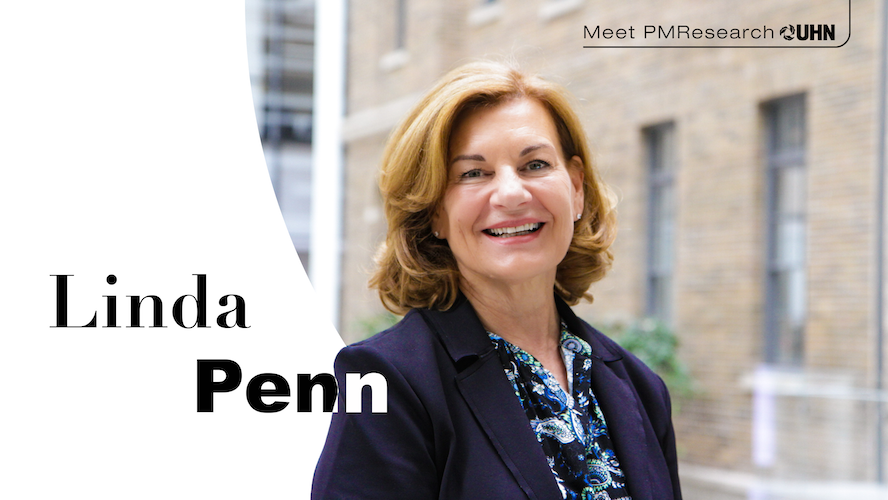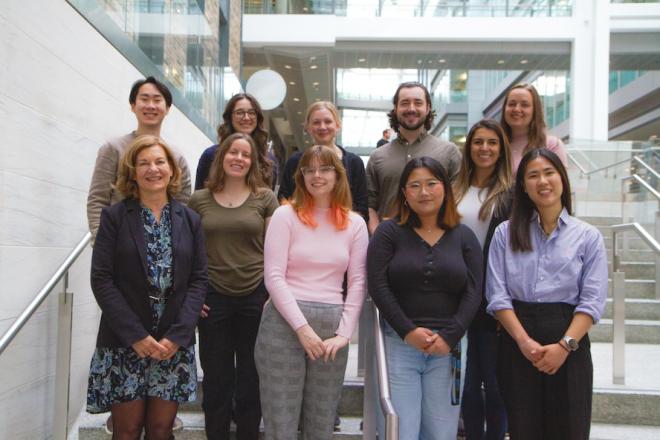
In the 1980s, scientists identified MYC, a powerful protein linked to more than 50% of human cancers, contributing to tumour growth.
For nearly 30 years, Dr. Linda Penn has been at the forefront of MYC research, uncovering how cancer cells rely on this potent cancer driver—and, more importantly, how to break that reliance to develop new treatments.
Here’s what we know about MYC, and two promising strategies Penn Lab is developing to treat cancers.
MYC: a spaghetti-like protein pulling the strings of cancer activities
“MYC can regulate several key biological activities to lock cancer cells in a state favourable for its growth,” says Dr. Penn. “It impacts cell cycle, immune response, metabolic processes, genomic instability, and cell stemness.”
“Instead of strongly regulating a select group of genes, MYC binds to 10-15% of all genes in the genome, subtly tweaking their activity, but it’s enough to tip the scales toward uncontrolled cell growth,” Dr. Penn explains. “MYC is a master orchestrator of cancer growth.”
Her lab contributed to this important insight by building a novel research tool with the PM Genomics Centre, called a CpG island microarray. This was one of the first multi-gene array technologies, developed to map MYC’s influence on genes, based on the observation that MYC recognizes GC-rich regions of the genome. The MYC-bound genes fell into broad functional categories, reinforcing the idea that MYC has a widespread influence on genes and regulates wide variety of cellular activities.
The link between MYC and cancer is well established, yet efforts to develop targeted therapies have faced persistent obstacles.
MYC is what scientists call an intrinsically disordered protein—instead of having a rigid shape like many other proteins, MYC is flexible and unstructured, like a tangle of spaghetti. This means it doesn’t have the usual “pocket” where a drug could easily bind and inhibit its function.
Breaking the bond between MYC and its partners
“We can’t block MYC directly. Our strategy is to disrupt MYC’s interactions with other proteins,” says Dr. Penn. To uncover the proteins that interact with MYC, Dr. Penn collaborated with Dr. Brian Raught, a pioneer in BioID (proximity-dependent biotinylation) at PM. Their breakthrough approach using BioID tracked MYC’s interactions inside the tumour cells in an unprecedented way—by tagging MYC with a biotin ligase, they could label all the proteins that came into close proximity with it. This technique provided a comprehensive map of MYC’s interaction network, significantly expanding the known library of proteins involved in MYC-driven cancer.
Since then, from hundreds of proteins identified, the team has been pinpointing those that have a higher significance for cancer growth and decoding their MYC interactions, such as PNUTS and TFIIF. “This is an ongoing effort that we are solving with Dr. Cheryl Arrowsmith and the Structural Genomics Consortium,” she says.
Building on these foundational studies, Dr. Penn’s lab performed high throughput screens identifying small molecules that can inhibit interactions between MYC and specific partner proteins—a fruitful collaboration with scientists at OICR and SRI. “Right now, we’re validating the inhibitor molecules in cells and refining their chemistry to make them more potent and effective.”
Statins: taking the fuel out of cancers
Despite the presence of strong cancer-drivers such as MYC, cancers cannot grow without the raw materials needed to build new cells—much like a high-performance engine revving without fuel—halted and nowhere to go.
It turns out a cellular metabolic process, called the mevalonate pathway, creates the “fuel”. This chain of biochemical reactions generates cholesterol, important for keeping cell membrane integrity and forming all types of hormones, essential for cancer cells’ growth and survival.
Penn’s team made groundbreaking contributions showing how statins, a class of cholesterol-lowering drugs, could be repurposed as potential cancer therapies. Statins block the mevalonate pathway, depriving cancer cells of needed materials and forcing the cancer’s engine to come to a stop. They showed the anti-cancer effects of statins in various cancer cell types including acute myeloid leukemia, prostate cancer, breast cancer, and multiple myeloma, in collaboration with many scientists at PM.
Early studies with Dr. Mark Minden showed statins selectively killed acute myeloid leukemia cells while sparing normal cells. Encouraged by these results, Penn’s team expanded their research to solid tumours like prostate and breast cancer.
The Penn lab found a feedback loop that can compensate and replenish the metabolic products needed for cancer growth, leading to resistance for the statin treatment. They used agents to block the statin-triggered feedback loop to achieve a better therapeutic effect.
“Our research taught us that we can ‘trick’ the cells into thinking that intracellular levels of cholesterol are still high. The agents we used structurally ‘look like’ cholesterol but they are standard-of-care drugs, like abiraterone, and block the feedback loop, so that statins’ anti-cancer effect wouldn’t be compensated, it was potentiated instead,” says Dr. Penn. “Working with Drs. Robert Hamilton and Neil Fleshner in prostate cancer studies, the team are marching forward with a clinical trial, using a combined therapy of statins and abiraterone to evaluate their anti-cancer efficacy and see how they work in prostate cancer patients.”
Similarly, statins’ anti-cancer effect and its resistance-inducing feedback loop are also present in breast cancer. Collaborating with Drs. Benjamin Haibe-Kains and David Cescon, the team conducted computational screening to find and validate several approved compounds that can potentiate the anti-breast cancer activity of statins.
“Our promissory note of working on statins is that they were already FDA and Health Canada approved, so our motivation is really to understand how they work and get them to the clinic as quickly as possible. Moving statins from the cardiac clinic where they are used to control cholesterol and now exploiting them as anti-cancer agents, we aim to benefit more patients worldwide.” Dr. Penn concludes.

Dr. Linda Penn and her current cohort of lab members.
Mentorship and Establishing the Office of Research Trainees (ORT) at UHN
As scientists continue to unravel MYC’s secrets, Penn’s work stands as a testament to the power of persistence in cancer research. “When I first entered this field, I thought, ‘Go big or go home,’” she recalls. “And there was nothing bigger than MYC at the time.”
Her bold approach has left a lasting impression on her students and trainees, who affectionately call her “a woman with no fear.” The phrase has even become a fixture in her office—a sign gifted to her by her trainees that serves as both a tribute to her fearless mindset and an inspiration to those who step through her door. Students turn to her for guidance as they navigate their own paths, and her deep commitment to mentorship was honoured with the 2020 Richard Hill Mentorship Award at PM.
“Everyone's scientific career is shaped by their own unique journey, and they take on different lenses to view and solve real-world problems. By empowering young scientists, we foster innovative solutions to shape a better future.”
Dr. Linda Penn played a pivotal role in establishing the Office of Research Trainees (ORT) at the University Health Network (UHN)—an initiative designed to support and empower graduate students and postdoctoral researchers as they navigate their scientific careers. What started as a small project on the side of her desk in 2011 has grown into a thriving program that now oversees over 1,200 trainees across UHN, offering them career development, mentorship, and essential training opportunities.
Today, ORT offers a diverse range of workshops, covering everything from scientific writing and presenting research to peer-to-peer training sessions on technical skills. One of ORT’s standout initiatives is career panels, which allow trainees to engage directly with professionals from fields like the pharmaceutical industry, science communication, and marketing. These interactions provide young researchers opportunities to explore non-traditional career paths, gain firsthand insights, and even establish mentorship connections that shape their professional journeys.
For Dr. Penn, ORT is not just a program—it’s a platform that empowers young scientists to take charge of their futures.
"It’s important to have a clear vision to know where you're going and what you want to achieve,” she reflects. Through ORT, Penn and her current colleagues Dr. Amanda Veri and Jordan Beck are building a supportive ecosystem where young scientists can embrace risk, push boundaries, and ultimately pave the way for the next generation of discoveries.

The Office of Research Trainees (ORT) team at UHN, from left to right: Jordan Beck, Research Trainee Coordinator; Dr. Linda Penn, ORT Director; and Dr. Amanda Veri, ORT Manager.
Meet PMResearch is a story series that features Princess Margaret researchers. It showcases the research of world-class scientists, as well as their passions and interests in career and life—from hobbies and avocations to career trajectories and life philosophies. The researchers that we select are relevant to advocacy/awareness initiatives or have recently received awards or published papers. We are also showcasing the diversity of our staff in keeping with UHN themes and priorities.




